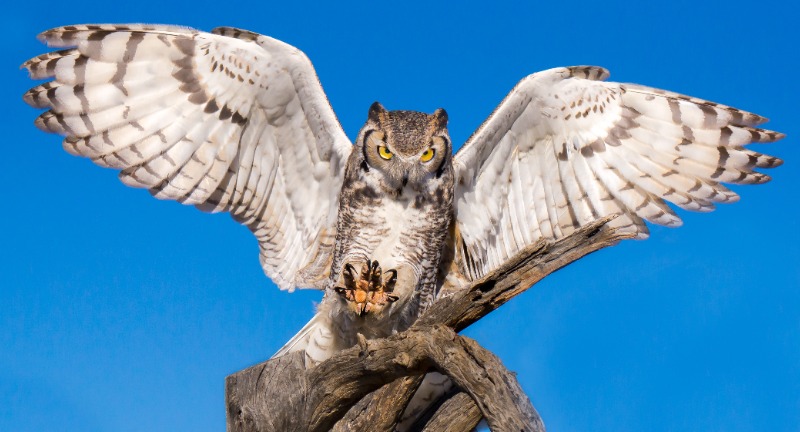NEWS
Eyes of the Night: 20 Incredible Facts About the Great Horned Owl
Published
4 months agoon

Shutterstock
With piercing yellow eyes and signature feathered “horns,” the great horned owl is one of the most captivating predators of the night. Revered for its silent flight and formidable hunting skills, this owl rules the skies with unmatched stealth and precision. From its ability to adapt to nearly any environment to its unique dietary choices, this bird is a testament to nature’s ingenuity. Its haunting hoots and mysterious presence have made it a symbol of wisdom and power in cultures around the world.
Dive into the fascinating world of the great horned owl and discover incredible facts about this awe-inspiring bird of prey.
Powerful Predators

Shutterstock
Great horned owls are among the most formidable predators in their ecosystems. They hunt an extensive variety of prey, ranging from small mammals like mice and rabbits to larger creatures, including other birds and even skunks. Their versatility in hunting ensures they thrive in diverse environments, maintaining balance in the food chain. These owls are a true testament to nature’s design, perfectly equipped to dominate their surroundings.
Remarkable Hearing

Shutterstock
The hearing ability of a great horned owl is nothing short of extraordinary. Their asymmetrical ears, positioned at different heights on their head, help them pinpoint sounds with surgical precision. This capability allows them to detect the faintest rustles of prey under leaves or snow, even in pitch-black darkness. Their hearing is so acute it is sometimes likened to a natural sonar system.
Night Vision Masters

Shutterstock
Great horned owls have large eyes that capture even the faintest traces of light, enabling excellent night vision. These birds rely on their superior sight to hunt effectively under the cover of darkness. Unlike human eyes, theirs are fixed in their sockets, so they rotate their heads up to 270 degrees to survey their surroundings. This remarkable adaptation makes them one of the most efficient nocturnal predators in the animal kingdom.
Silent Flyers

Shutterstock
Unlike most birds, great horned owls have specialized feathers with serrated edges that disrupt airflow, allowing them to fly silently. This stealthy flight is crucial for sneaking up on prey without being detected. Their silent approach, combined with their speed and precision, leaves their victims with little chance to escape. This feature underscores why they are often referred to as “ghosts of the forest.”
Iconic Tufts
Shutterstock
The feather tufts on a great horned owl’s head, resembling “horns,” are one of their most recognizable features. While these tufts are not functional ears, they serve important roles, such as breaking up the owl’s outline for camouflage and signaling their mood to others. Depending on their posture, these tufts can indicate aggression, alertness, or curiosity. This distinctive trait has made them a symbol of mystery and intrigue in many cultures.
Widespread Habitat

Shutterstock
Few animals can boast the adaptability of the great horned owl, which thrives in an array of habitats. From dense forests and arid deserts to swamps and bustling cities, they have an uncanny ability to adjust to different environments. Their resilience is one reason they are among the most common owl species in the Americas. Wherever there is suitable prey and nesting sites, great horned owls are likely to be found.
Mighty Grip

Shutterstock
The talons of a great horned owl are its most deadly weapon, capable of exerting a crushing force of up to 300 psi. This incredible strength allows them to capture and subdue prey much larger than themselves. They use their talons to pierce vital areas, ensuring a quick and effective kill. This powerful grip also helps them hold onto struggling prey as they take it back to their perch.
Diverse Diet

Shutterstock
Great horned owls are highly opportunistic, consuming an astounding variety of prey. Their diet includes small mammals, birds, reptiles, amphibians, insects, and even fish, depending on availability. This adaptability ensures they can survive in changing environments where food sources may vary. Their dietary flexibility is a major factor behind their widespread distribution and ecological success.
Recycling Nests

Shutterstock
Great horned owls are resourceful nesters, often taking over nests built by other birds like hawks, crows, or herons. They are not picky about the condition of the nest and will use it with minimal to no modifications. This opportunistic behavior saves them the effort of building their own nests, allowing them to focus on hunting and raising their young. This habit highlights their adaptability and efficient use of resources.
Early Breeders

Shutterstock
Unlike most birds that breed in the spring, great horned owls start their breeding season in winter, with eggs laid as early as January. This timing gives their young a head start in developing before other predators become active. Despite the harsh conditions, the owls are well-adapted to protect their eggs and chicks from the cold. This early nesting strategy is another testament to their resilience and survival skills.
Camouflaged Plumage

Shutterstock
The mottled brown, gray, and white feathers of a great horned owl blend seamlessly into tree bark and natural surroundings. This camouflage provides excellent protection from predators and helps them ambush prey. When perched motionless, they are nearly impossible to spot, even in daylight. This stealthy adaptation is vital to their role as a top predator.
Adaptable Communication

Shutterstock
While their deep hoots are most commonly associated with great horned owls, they are capable of a range of vocalizations, including screeches, barks, and hisses. Each sound serves a specific purpose, such as defending territory, warning threats, or communicating with their mate. Their vocal adaptability enhances their ability to thrive in varied environments. Their haunting calls have also inspired many legends and folklore.
Fiercely Territorial

Shutterstock
Great horned owls are highly territorial and will aggressively defend their nesting sites. They have been known to attack larger birds, such as eagles and hawks, that encroach on their territory. This fierce protection ensures the safety of their eggs and chicks. Their territorial behavior makes them a dominant presence wherever they reside.
Intense Parental Care

Shutterstock
Both male and female great horned owls are deeply invested in the care of their young. The male takes on the role of primary hunter, bringing food to the nest, while the female guards and feeds the chicks. Their cooperative efforts ensure the survival of the next generation. This strong parental bond highlights the importance of teamwork in the owl’s life cycle.
Longevity in the Wild

Shutterstock
In the wild, great horned owls can live up to 13 years, with some reaching 20 years or more under ideal conditions. Their long lifespan is attributed to their adaptability, keen senses, and few natural predators. However, threats such as habitat loss, vehicle collisions, and poisoning from rodent control efforts can impact their survival. Conservation efforts help ensure these majestic birds continue to thrive.
Sharp Beak and Talons

Shutterstock
Equipped with razor-sharp talons and a hooked beak, great horned owls are perfectly designed to capture and consume prey. Their beaks are used to tear flesh into smaller, manageable pieces for eating. These adaptations allow them to tackle a wide variety of prey, contributing to their reputation as fearsome hunters. Their tools of survival are both elegant and deadly.
Symbolism in Culture

Shutterstock
Great horned owls have been revered and feared in various cultures throughout history. Often seen as symbols of wisdom and mystery, they have also been associated with omens and the supernatural. Their nocturnal habits and eerie calls make them a frequent subject of myths and folklore. This cultural significance adds to their allure and mystique.
Largest Range in the Americas

Shutterstock
From the cold tundra of Alaska to the tropical forests of South America, great horned owls have one of the widest ranges of any owl species. This adaptability is a testament to their ability to thrive in diverse climates and habitats. They are equally at home in remote wilderness as they are in suburban backyards. Their widespread presence makes them an iconic species across the Americas.
Fledgling Skills

Shutterstock
Before fully learning to fly, young owls engage in “branching,” where they climb and hop between branches to strengthen their wings. This stage is crucial for their development, allowing them to build the skills and confidence needed for flight. During this time, they remain under the watchful eyes of their parents. Branching is an important milestone in their journey to independence.
Weight Variance by Region

Shutterstock
Great horned owls living in colder climates tend to be larger and heavier than their counterparts in warmer regions. This phenomenon, known as Bergmann’s Rule, helps them conserve heat in harsher environments. Conversely, smaller owls in warmer areas are better suited for heat dissipation. This regional variation underscores their adaptability to different habitats.
Conclusion

Shutterstock
The great horned owl is a true testament to the power and adaptability of nature’s top predators. From its silent flight and extraordinary hunting abilities to its resilience across diverse habitats, this majestic bird continues to captivate and inspire. Its role in ecosystems as a fierce predator and its cultural symbolism highlight its enduring significance. Whether glimpsed in the wild or admired from afar, the great horned owl remains a fascinating emblem of the natural world.
More Amazing Animals+
-


17 of the Rarest Creatures in Australia
-


Lazy pooch gets paddle board tow
-


25 Reasons Why Afghan Hounds Are Walking Works of Art
-


Danish Royal Life Guards escort duck family to Copenhagen harbor
-


Goats Ushered Across a Road to Aid in California Fire…
-


25 Things That Make Newfoundland Dogs Gentle Family Guardians
-


24 Surprising Features of Dalmatian Dogs That Go Beyond Their…
-


25 Iconic Animals of the African Safari
-


More – Alligator arrest outside of a school in Charleston,…
-


25 Ways Toy Fox Terriers Capture Our Hearts
-


Black bear crossing assisted by Ephraim City Police
-


25 Things To Love About The Chesapeake Bay Retriever
